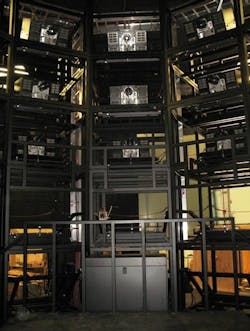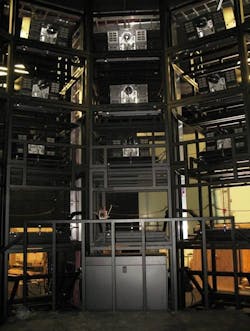NASA taps NVIDIA Quadro GPU technology to build ultra-high-resolution flight simulators
MOFFETT FIELD, Calif., 7 Dec. 2012. Young military pilots starting their flying careers have 20/13 eyesight, which enables them to see far more detail than most visual systems provide; yet, most flight simulators only offer 20/40 vision–meaning that important details are often blurred or not easily identifiable to the pilot.
Engineers at NASA Ames Research in Moffett Field, Calif., have been co-developing a visual system for a flight simulator with the United States Air Force Research Labs (AFRL); NASA and AFRL engineers will use the device to explore the various elements of vision within a flight simulator where the acuity of the displayed images will be 20/10.
John Archdeacon, lead IG (Image Generator) developer at NASA Ames Research, describes the device and the process below and in his blog.
The simulator uses nine 4K (4096×2160) projectors in a dome; the images overlap and are edge-blended to provide the pilot a seamless view of the simulated outside world at more than 36 times the resolution of a standard high-definition television (HDTV).
An Image Generator (IG) is the name given to the collection of computers, graphics subsystems, visual databases, and control and rendering software operating together to graphically simulate synthetic worlds in real time.
“Traditionally, a large cluster of computers would be used to drive a configuration likes ours. If we configured the USAF simulator with a traditional IG architecture, maintaining a 60 frames-per-second update rate would require 36 computers, each rendering a small portion of the screen. These clusters are large, complex and can be difficult to manage,” says Archdeacon. “For this project, we used NVIDIA’s Quadro SVS technology and reduced the overall complexity down to five computers, each driving multiple Quadro GPUs and Quadro Sync cards to one or two 4K dome projectors.”
NASA—together with NVIDIA, Sony, and VDC Display Systems—presented its work on this simulator at the I/ITSEC tradeshow in Orlando.
Related stories
Read Archdeacon’s blog
Visit the Flight Training & Simulation Topic Center
Visit the Space Topic Center.
Follow Avionics Intelligence news updates on Twitter (@Avionics_Intel), LinkedIn, and Google+.

